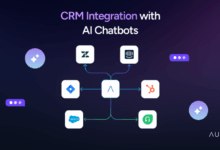CRM for Sales Marketing Automation
CRM for Sales Marketing Automation represents a powerful synergy, streamlining sales and marketing efforts for enhanced efficiency and improved ROI. This integrated approach leverages technology to nurture leads, automate repetitive tasks, and ultimately drive revenue growth. By aligning sales and marketing teams through a centralized platform, businesses can gain a comprehensive view of the customer journey, fostering stronger relationships and boosting conversion rates.
This exploration delves into the core functionalities of a CRM designed for sales and marketing automation, highlighting key differences between solely sales-focused CRMs and those with integrated marketing capabilities. We will examine collaborative strategies, compare leading platforms, and analyze the significant benefits of this integrated approach, including its impact on lead nurturing, customer relationship management, and overall customer lifetime value. The discussion will also cover essential features, implementation strategies, and methods for measuring success and return on investment.
Defining CRM for Sales Marketing Automation
A Customer Relationship Management (CRM) system, when enhanced with marketing automation capabilities, becomes a powerful tool for streamlining sales and marketing processes. It centralizes customer data, automates repetitive tasks, and provides valuable insights to improve overall efficiency and revenue generation. This integration fosters seamless collaboration between sales and marketing teams, leading to a more unified and effective approach to customer engagement.
Core CRM functionality for sales and marketing automation encompasses several key areas. At its heart, a CRM stores and manages comprehensive customer data, including contact information, interaction history, purchase details, and lead qualification scores. This data fuels automation features such as automated email sequences triggered by specific customer actions (e.g., website visits, form submissions), lead scoring algorithms to prioritize high-potential prospects, and automated task assignments for sales representatives. Marketing automation tools within the CRM facilitate the creation and scheduling of targeted email campaigns, social media posts, and other marketing materials, all while tracking performance metrics in real-time. The system also enables sales pipeline management, providing a clear view of the sales process and identifying potential bottlenecks. Finally, robust reporting and analytics dashboards offer valuable insights into campaign performance, sales productivity, and overall customer engagement.
Differences Between Sales-Only CRM and Integrated CRM
A CRM solely focused on sales primarily manages the sales pipeline, tracks deals, and facilitates communication between sales representatives and customers. While it may include some basic reporting features, it lacks the sophisticated marketing automation capabilities found in integrated systems. An integrated CRM, on the other hand, offers a comprehensive platform encompassing both sales and marketing functions. This allows for seamless data flow between the two departments, enabling targeted marketing campaigns based on sales data and vice-versa. The key difference lies in the ability to automate marketing activities, personalize customer interactions, and gain deeper insights into customer behavior through integrated analytics. For example, an integrated CRM can automatically nurture leads based on their engagement with marketing materials, while a sales-only CRM would require manual intervention for similar actions.
Sales and Marketing Team Collaboration Examples
Imagine a scenario where a marketing campaign generates a significant number of leads. In an integrated CRM, these leads are automatically scored based on their engagement with the campaign and their profile information. High-scoring leads are then automatically routed to the appropriate sales representative, who receives a notification and all relevant customer information within the CRM. The sales representative can then personalize their outreach based on the lead’s engagement history, increasing the chances of conversion. Conversely, sales data, such as deal size or customer feedback, can inform future marketing campaigns, ensuring that marketing efforts are aligned with sales priorities. This closed-loop system, facilitated by the integrated CRM, enhances overall efficiency and maximizes the impact of both sales and marketing efforts. For example, if a particular marketing message resonates strongly with a specific customer segment, this information can be used to tailor future campaigns, leading to improved ROI.
Comparison of CRM Platforms
The following table compares three hypothetical CRM platforms (Platform A, Platform B, and Platform C) with sales and marketing automation capabilities. These are illustrative examples and do not represent specific products.
| Feature | Platform A | Platform B | Platform C |
|---|---|---|---|
| Lead Scoring | Basic lead scoring with limited customization | Advanced lead scoring with multiple scoring models and custom fields | Advanced lead scoring with predictive analytics and AI-powered scoring |
| Email Marketing Integration | Basic integration with popular email marketing platforms | Seamless integration with multiple email marketing platforms, including advanced automation features | Built-in email marketing platform with robust automation and personalization capabilities |
| Sales Pipeline Management | Visual sales pipeline with basic drag-and-drop functionality | Advanced sales pipeline management with customizable stages, forecasting tools, and reporting | AI-powered sales pipeline management with predictive analytics and automated task assignments |
| Reporting Dashboards | Basic reporting dashboards with limited customization | Customizable reporting dashboards with various metrics and visualizations | Interactive dashboards with real-time data and advanced analytics |
Benefits of Integrated Sales and Marketing Automation
Integrating sales and marketing automation within a CRM system offers significant advantages, streamlining workflows and boosting overall business efficiency. This synergy allows for a more holistic view of the customer journey, enabling businesses to nurture leads more effectively and close deals faster. The result is a more robust and profitable sales process.
Improved lead nurturing significantly impacts sales conversion rates by providing a personalized and timely response to each prospect. This targeted approach, facilitated by automation, ensures that leads receive relevant information at the right stage of their buying journey, increasing their likelihood of conversion. This contrasts sharply with traditional methods, which often relied on broad, less targeted communications.
Improved Lead Nurturing and Sales Conversion Rates
Effective lead nurturing, powered by integrated sales and marketing automation, is crucial for maximizing conversion rates. By automating repetitive tasks such as email sequences and personalized content delivery, sales and marketing teams can focus on higher-value activities like building relationships and closing deals. Automated workflows can segment leads based on their behavior and engagement, ensuring they receive the most relevant information at each stage. For example, a lead who downloads a white paper might receive a follow-up email with a case study, while a lead who attends a webinar might receive a personalized demo invitation. This tailored approach significantly increases the chances of converting leads into paying customers. A study by MarketingSherpa found that nurtured leads generate 50% more sales-ready leads at a 33% lower cost.
Enhanced Customer Relationship Management and Customer Lifetime Value
Integrated sales and marketing automation dramatically improves customer relationship management (CRM) by providing a unified view of customer interactions across all touchpoints. This 360-degree view enables businesses to understand customer needs and preferences more effectively, leading to more personalized interactions and stronger customer relationships. Furthermore, the automation of tasks such as customer onboarding and support requests frees up time for sales and marketing teams to focus on building stronger relationships with key customers. This, in turn, leads to increased customer lifetime value (CLTV) as satisfied customers are more likely to make repeat purchases and refer new business. Companies like Salesforce have demonstrated the success of this approach, showcasing increased customer retention and higher average revenue per customer through improved CRM practices facilitated by automation.
Streamlined Workflow and Increased Efficiency
A CRM with integrated sales and marketing automation streamlines workflows by automating repetitive tasks, freeing up valuable time for sales and marketing teams to focus on strategic initiatives. This automation can encompass various processes, from lead qualification and scoring to appointment scheduling and follow-up communications. For example, automatically assigning leads to the appropriate sales representative based on predefined criteria eliminates manual sorting and ensures timely responses. This efficiency boost translates directly to improved productivity and increased sales. Companies utilizing this approach often report significant reductions in operational costs and improved sales team morale due to reduced administrative burden.
Improved Sales Forecasting and Reporting
The data-driven nature of a CRM with integrated sales and marketing automation provides valuable insights into sales performance, enabling more accurate forecasting and reporting. By tracking key metrics such as lead generation, conversion rates, and customer lifetime value, businesses can identify areas for improvement and make data-driven decisions to optimize their sales and marketing strategies. The ability to generate real-time reports provides immediate feedback on the effectiveness of campaigns and allows for adjustments to be made promptly. This level of transparency and insight is invaluable for making informed business decisions and maximizing ROI.
Visual Representation of Workflow
Imagine a flowchart. It begins with Lead Generation (e.g., website forms, social media ads). Leads are then automatically Qualified and Segmented based on pre-defined criteria within the CRM. Automated Nurturing Campaigns (email sequences, personalized content) are triggered. Engaged leads are then Assigned to Sales Representatives, who use the CRM to manage interactions. Sales representatives track interactions, progress, and close deals. Finally, Post-Sale Follow-up is automated, strengthening customer relationships and encouraging repeat business. The entire process is tracked and analyzed within the CRM, providing valuable data for optimization.
Key Features of a CRM for Sales Marketing Automation
A robust CRM system designed for sales and marketing automation goes beyond basic contact management. It integrates various functionalities to streamline processes, improve team collaboration, and ultimately boost sales performance. The key lies in the seamless integration of lead nurturing, sales pipeline management, and marketing automation tools within a centralized platform. This allows for a more efficient and effective approach to managing customer interactions and driving revenue growth.
Lead Management Capabilities
Effective lead management is crucial for nurturing prospects and converting them into paying customers. A good CRM system provides tools to capture, qualify, and segment leads based on various criteria, such as demographics, engagement levels, and purchase history. This allows sales and marketing teams to prioritize high-potential leads and tailor their outreach accordingly. For example, a CRM might automatically score leads based on website activity, email opens, and downloaded resources, prioritizing those showing the highest levels of engagement. This targeted approach increases conversion rates and reduces wasted effort on unqualified leads.
Sales Pipeline Management
Visualizing and managing the sales pipeline is essential for tracking progress and identifying bottlenecks. A powerful CRM provides tools to create custom sales stages, assign leads to sales representatives, and monitor the movement of leads through the pipeline. Real-time dashboards offer a clear overview of the sales process, allowing managers to identify potential issues and proactively address them. For instance, if a particular stage shows a high drop-off rate, managers can investigate the cause and implement strategies to improve conversion at that point. This data-driven approach ensures a more efficient and predictable sales process.
Marketing Automation Features
Marketing automation streamlines repetitive tasks, allowing marketing teams to focus on strategic initiatives. This includes features such as automated email sequences, social media scheduling, and campaign performance tracking. A well-integrated CRM allows for personalized email campaigns based on lead segmentation and behavior. For example, a CRM could automatically send a series of emails to a new lead, providing them with valuable content and gradually guiding them towards a purchase. Similarly, social media posts can be scheduled and tracked within the CRM, providing a complete view of marketing efforts. This integrated approach ensures consistency and efficiency in marketing communications.
Reporting and Analytics
Data-driven decision-making is crucial for optimizing sales and marketing strategies. A comprehensive CRM provides robust reporting and analytics capabilities, offering insights into key performance indicators (KPIs) such as lead conversion rates, sales cycle length, and marketing ROI. These reports allow businesses to identify areas for improvement and measure the effectiveness of different strategies. For example, analyzing conversion rates at different stages of the sales funnel can highlight bottlenecks and inform adjustments to the sales process. Similarly, tracking marketing campaign performance allows businesses to optimize their spending and maximize their return on investment.
Integration of Email and Social Media Marketing
The seamless integration of email and social media marketing within the CRM’s marketing automation features is paramount. This integration allows for personalized, multi-channel campaigns that engage leads across various touchpoints. For instance, a lead who interacts with a social media post might automatically be added to a targeted email sequence, receiving personalized content relevant to their interests. This coordinated approach enhances brand awareness, increases engagement, and ultimately drives conversions. The ability to track engagement across both channels within the CRM provides valuable data for optimizing future campaigns.
Implementation and Integration Strategies
Implementing a CRM system for sales and marketing automation, while offering significant benefits, presents several challenges. Successfully navigating these hurdles requires a well-defined strategy, meticulous planning, and a commitment to ongoing optimization. The integration process itself can be complex, particularly when dealing with legacy systems and diverse data formats. However, with careful execution, the rewards of a streamlined, data-driven approach to sales and marketing far outweigh the initial investment of time and resources.
Challenges in CRM Implementation
Businesses often encounter difficulties during CRM implementation, ranging from data migration complexities to user adoption issues. Resistance to change among employees accustomed to existing workflows is a common obstacle. Insufficient training and inadequate support can hinder user proficiency and lead to low adoption rates. Data cleansing and standardization before migration can be time-consuming and resource-intensive, requiring careful planning and potentially specialized expertise. Furthermore, integrating the CRM with existing systems (ERP, marketing automation platforms, etc.) can be technically challenging, requiring careful consideration of data formats and APIs. Finally, inaccurate or incomplete data within the CRM, even after migration, can compromise the system’s effectiveness and the reliability of insights generated.
Best Practices for Integration with Existing Systems
Successful integration of a CRM with existing business systems hinges on a phased approach, starting with a thorough assessment of current systems and their capabilities. Prioritize seamless data flow between the CRM and other key platforms. This may involve utilizing APIs (Application Programming Interfaces) to enable real-time data synchronization. Consider using an integration platform as a service (iPaaS) to simplify the process and manage connections between different applications. Regular testing throughout the integration process is crucial to identify and resolve potential issues early on. Establish clear data mapping rules to ensure consistent data representation across all integrated systems. Finally, document all integration processes meticulously to facilitate troubleshooting and future modifications.
Step-by-Step Data Migration Plan
A successful data migration requires a structured approach. First, conduct a comprehensive data audit of existing systems to identify data quality issues, inconsistencies, and redundancies. Next, develop a detailed data mapping plan, outlining how data from existing systems will be transformed and mapped to the CRM’s data structure. Then, perform a data cleansing process to correct inaccuracies and inconsistencies in the source data. Following this, implement a phased migration approach, starting with a pilot migration of a subset of data to test the process and identify any unforeseen issues. After successful pilot testing, proceed with the full data migration, closely monitoring the process for any errors or discrepancies. Finally, conduct thorough post-migration validation to ensure data integrity and accuracy within the new CRM system.
Pre-Implementation, During Implementation, and Post-Implementation Checklist
Before implementation, assess business needs, select appropriate CRM software, secure buy-in from stakeholders, and train users. During implementation, establish clear project timelines, monitor progress regularly, address integration challenges proactively, and provide ongoing user support. After implementation, continuously monitor system performance, gather user feedback, optimize workflows based on usage patterns, and plan for future upgrades and enhancements. This proactive approach ensures the CRM remains a valuable asset, driving sales and marketing effectiveness.
Closing Notes
In conclusion, implementing a CRM for sales and marketing automation offers businesses a significant competitive advantage. By centralizing data, automating processes, and fostering collaboration between sales and marketing teams, companies can optimize their workflows, improve lead nurturing, and ultimately boost their bottom line. The careful selection of a platform, strategic implementation, and consistent monitoring of key performance indicators are crucial for realizing the full potential of this powerful technology and achieving a substantial return on investment.





